Mongolia: An example of religious coexistence and harmony in humanity
Pope at ecumenical and interreligious meeting at the Hun Theatre
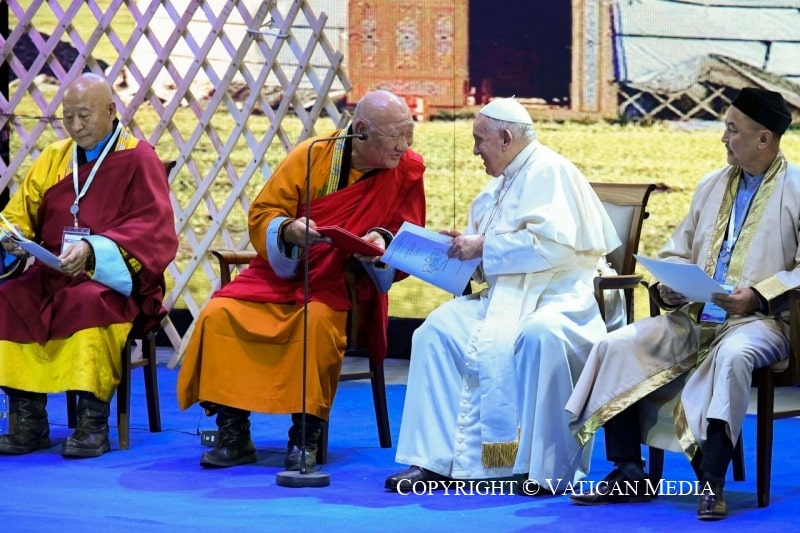
This morning, after leaving the Apostolic Prefecture, the Holy Father transferred by car to the Hun Theatre where, at 10.10 a.m. (04.10 a.m. Rome’s time), the Ecumenical and Interreligious Meeting took place.
Upon his arrival, the Pope was welcomed at the entrance by the Apostolic Prefect of Ulaanbaatar, His Eminence Card. Giorgio Marengo, I.M.C., and by a religious leader. Then, after the welcoming speech by His Eminence Khamba Lama Gabju Demberel Choijamts, Abbot of the Gandan Tegchenling Monastery, and the reading of messages from 11 leaders of different religions, Pope Francis delivered his address.
At the end, after the group photo, the Holy Father returned by car to the Apostolic Prefecture where he had a private lunch.
We publish below the speech that the Pope delivered at the Ecumenical and Interreligious Meeting:
Address of His Holiness
Good morning to all of you, dear brothers and sisters!
Allow me to address you in this way, as a brother in faith to those who believe in Christ, and as a brother to all of you in the name of our shared religious quest and our membership in the one human family. In terms of that religious quest, humanity can be compared to a band of wayfarers treading the earth with eyes lifted to heaven. A traveler from afar once observed that here in Mongolia he saw “nothing but the sky and earth.” (cf. WILLIAM OF RUBRUK, Viaggio in Mongolia, XIII/3, Milan 2014, 63). Here indeed, the sky, so clear and blue, embraces these vast and imposing lands, as if to remind us of the two essential aspects of human life: the earthly, made up of our relationships with others, and the heavenly, consisting in our quest for the transcendent Other. Mongolia thus reminds all of us, as pilgrims and wayfarers, to lift our gaze on high in order to discern which path to follow on our journey here below.
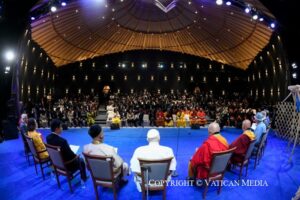 I am happy to be with you for this significant moment of encounter. I thank each of you most heartily for your presence and for every one of the talks that have enriched our common reflection. The fact that we are meeting together in one place already sends a message: it shows that the religious traditions, for all their distinctiveness and diversity, have impressive potential for the benefit of society as a whole. If the leaders of nations were to choose the path of encounter and dialogue with others, it would certainly be a decisive contribution to ending the conflicts continuing to afflict so many of the world’s peoples.
I am happy to be with you for this significant moment of encounter. I thank each of you most heartily for your presence and for every one of the talks that have enriched our common reflection. The fact that we are meeting together in one place already sends a message: it shows that the religious traditions, for all their distinctiveness and diversity, have impressive potential for the benefit of society as a whole. If the leaders of nations were to choose the path of encounter and dialogue with others, it would certainly be a decisive contribution to ending the conflicts continuing to afflict so many of the world’s peoples.
The beloved Mongolian people have made it possible for us to come together for our mutual enrichment, for they can vaunt a history of coexistence between the followers of various religious traditions. It is impressive to think of Kharakorum, the ancient imperial capital, which admirably housed within its walls places of worship belonging to different creeds, thus exemplifying a commendable harmony. Harmony. I would like to stress this word, in its typically Asian accents. Harmony is that special relationship born of the creative interplay of differing realties, without imposition or amalgamation, but with complete respect for their differences, in view of a serene life in common. I ask myself: Who, more than believers, is called to work for harmony among all?
Brothers and sisters, the social significance of our religious traditions can be gauged by the extent to which we are capable of living in harmony with other pilgrims on this earth and can foster that harmony in the places where we live. Every human individual, and even more every religion, must be measured by the standard of altruism. Not altruism in the abstract, but in the concrete: an altruism that translates into concern for others and generous cooperation with them. For “the wise man rejoices in giving, and by that alone does he become happy” (The Dhammapada: The Buddha’s Path of Wisdom, Sri Lanka 1985, n. 177; cp. the saying of Jesus found in Acts 20:35). In the words of a prayer inspired by Francis of Assisi, “Where there is hatred, let me bring love, where there is offence, let me bring pardon, where there is discord, let me bring union”. Altruism builds harmony and wherever there is harmony, we find understanding, prosperity and beauty. Harmony may well be the best synonym of beauty. Whereas narrowness, unilateral imposition, fundamentalism and ideological constraint destroy fraternity, fuel tensions and compromise peace, the beauty of life is born of harmony, which is inherently communitarian: it flourishes through kindness, listening and humility. And those who are pure of heart embrace harmony, for true beauty, as Gandhi said, lies in purity of the heart.
The religions are called to offer the world this harmony, which technological progress alone cannot bestow, since, in its concern with the earthly, horizontal dimension of humanity, it risks forgetting heaven, for which we were made. Sisters and brothers, today we are meeting together as the humble heirs of ancient schools of wisdom. In our encounter with one another, we want to share the great treasure we have received, for the sake of enriching a humanity so often led astray on its journey by the myopic pursuit of profit and material comfort. People in our time are often unable to find the right path: concerned only with earthly interests, humanity ends up destroying the earth and mistaking progress for regress, as attested by so many injustices, conflicts, persecutions, environmental disasters and great disregard for human life.
Here, Asia has much to offer and Mongolia, which lies at the heart of this continent, possesses a great patrimony of wisdom that its various religions have helped to create and that I would like to urge all to explore and appreciate. I will limit myself to mentioning, albeit briefly, ten aspects of this patrimony: a healthy relationship to tradition, despite the temptations of consumerism; respect for your elders and ancestors – today how greatly do we need a generational covenant between old and the young, a dialogue between grandparents and grandchildren! Also, care for the environment, our common home, another great and pressing need, for we are in peril. Then too, the value of silence and the interior life, as a spiritual antidote to so many ills in today’s world. Also, a healthy sense of frugality; the value of hospitality; the ability to resist attachment to material objects; the solidarity born of a culture of interpersonal bonds; and respect for simplicity. Finally, a certain existential pragmatism that tenaciously pursues the good of individuals and of the community. These ten aspects are some elements of the patrimony of wisdom that this country is able to offer to the world.
Speaking of these elements, I have already mentioned how, as I prepared for this journey, I was fascinated by the traditional dwellings that serve as an expression of the Mongolian people’s wisdom accrued over millennia of history. The ger creates a humane space: it is the place for family life, friendly conviviality, encounter and dialogue able to make room, even in a crowd, for each individual. Then too, it is a concrete landmark, easily identifiable in the vast expanses of Mongolian territory, and a source of hope for those who have lost their way, for wherever there is a ger, there is life. It is always open, ready to welcome friends, but also travelers and even strangers, and to offer either a steaming drink of tea to restore strength in the cold of winter, or a sip of fresh milk to provide refreshment on steamy summer days. This was the experience of the Catholic missionaries from other countries who were welcomed here as pilgrims and guests, and gently entered into this culture, bringing their humble testimony to the Gospel of Jesus Christ.
Together with its human space, the ger also expresses an essential openness to the divine. This spiritual dimension is represented by its overhead opening, which admits a beam of light that makes the interior, as it were, a great sundial marking, through an interplay of light and shadow, the hours of day and night. There is a beautiful lesson in this: the sense of the passage of time comes from above, not simply from the flux of earthly activity. At certain times of the year, the ray that penetrates from on high lights up the domestic altar, reminding us of the primacy of the spiritual life. In this way, the sense of human togetherness experienced in this circular space is constantly referred back to its vertical vocation, to its transcendent and spiritual calling.
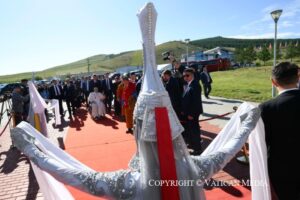 The reconciled and prosperous humanity that we, as followers of different religions, seek to promote is thus symbolized by this harmony, togetherness and openness to the transcendent. And this, in turn, inspires a commitment to justice and peace, grounded in our relationship to the divine. In this sense, dear sisters and brothers, we share a great responsibility, especially in this period of history, for we are called to testify to the teachings we profess by the way we act; we must not contradict them and thus become a cause of scandal. There can be no mixing, then, of religious beliefs and violence, of holiness and oppression, of religious traditions and sectarianism. May the memory of past suffering – here I think especially of the Buddhist communities – bestow the strength needed to transform dark wounds into sources of light, senseless violence into wisdom of life, devastating evil into constructive goodness. May it be so for us, as committed followers of our respective spiritual masters and faithful stewards of their teachings, ever ready to offer the beauty of those teachings to those whom we daily encounter as friends and companions on our journey. May it be so, for in a pluralistic society committed to democratic values, such as Mongolia is, every religious institution, duly recognized by civil authority, has the duty, and above all the right, to freely express what it is and what it believes, in a way respectful of the conscience of others and in view of the greater good of all.
The reconciled and prosperous humanity that we, as followers of different religions, seek to promote is thus symbolized by this harmony, togetherness and openness to the transcendent. And this, in turn, inspires a commitment to justice and peace, grounded in our relationship to the divine. In this sense, dear sisters and brothers, we share a great responsibility, especially in this period of history, for we are called to testify to the teachings we profess by the way we act; we must not contradict them and thus become a cause of scandal. There can be no mixing, then, of religious beliefs and violence, of holiness and oppression, of religious traditions and sectarianism. May the memory of past suffering – here I think especially of the Buddhist communities – bestow the strength needed to transform dark wounds into sources of light, senseless violence into wisdom of life, devastating evil into constructive goodness. May it be so for us, as committed followers of our respective spiritual masters and faithful stewards of their teachings, ever ready to offer the beauty of those teachings to those whom we daily encounter as friends and companions on our journey. May it be so, for in a pluralistic society committed to democratic values, such as Mongolia is, every religious institution, duly recognized by civil authority, has the duty, and above all the right, to freely express what it is and what it believes, in a way respectful of the conscience of others and in view of the greater good of all.
In this regard, I would like to reassure you that the Catholic Church desires to follow this path, firmly convinced of the importance of ecumenical, interreligious and cultural dialogue. Her faith is grounded in the eternal dialogue between God and humanity that took flesh in the person of Jesus Christ. With humility and in the spirit of service that inspired the life of her Master, who came into the world not “to be served but to serve” (Mk 10:45), the Church today offers the treasure she has received to every person and culture, in a spirit of openness and in respectful consideration of what the other religious traditions have to offer. Dialogue, in fact, is not antithetical to proclamation: it does not gloss over differences, but helps us to understand them, to preserve them in their distinctiveness and to discuss them openly for the sake of mutual enrichment. In this way, we can discover in our common humanity, blessed by heaven, the key to our journey on this earth. Brothers and sisters, we share a common origin that confers equal dignity on everyone, and have a shared path that we can only travel alongside one another, as we dwell under the one sky that surrounds and illumines us.
Brothers and sisters, our coming together here today is a sign that hope is possible. It is possible to hope. In a world rent by conflict and discord, this may seem utopian, yet the greatest undertakings are hidden and almost imperceptible at the outset. While “the fragrance of flowers spreads only in the direction of the wind, the fragrance of those who live according to virtue spreads in all directions” (cf. The Dhammapada, No. 54). Let us make this conviction flourish, so that our common efforts to promote dialogue and the building of a better world will not be in vain. Let us cultivate hope. As a philosopher once said, “Everyone was great in proportion to the object of his hope. One was great by hoping for the possible; another by hoping for the eternal; but he who hoped for the impossible was the greatest of all” (SOREN KIERKEGAARD, Fear and Trembling). May the prayers we raise to heaven and the fraternity we experience here on earth spread seeds of hope. May they be a simple and credible testimony to our religiosity, our walking together with eyes lifted to heaven, our living in this world in harmony – let us never forget the word “harmony” – as pilgrims called to preserve the atmosphere of a home that is open to all people. Thank you.
Related
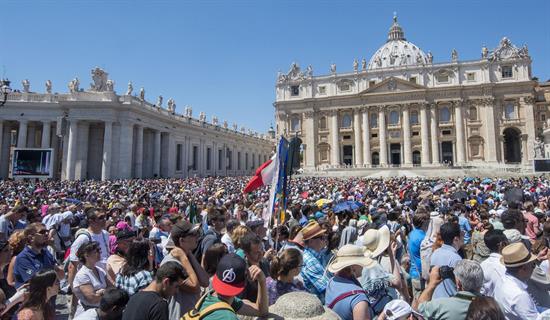
Pope Francis Sends a Message of Hope to the Young People of the UNIV 2025 International Congress
Exaudi Staff
11 April, 2025
5 min
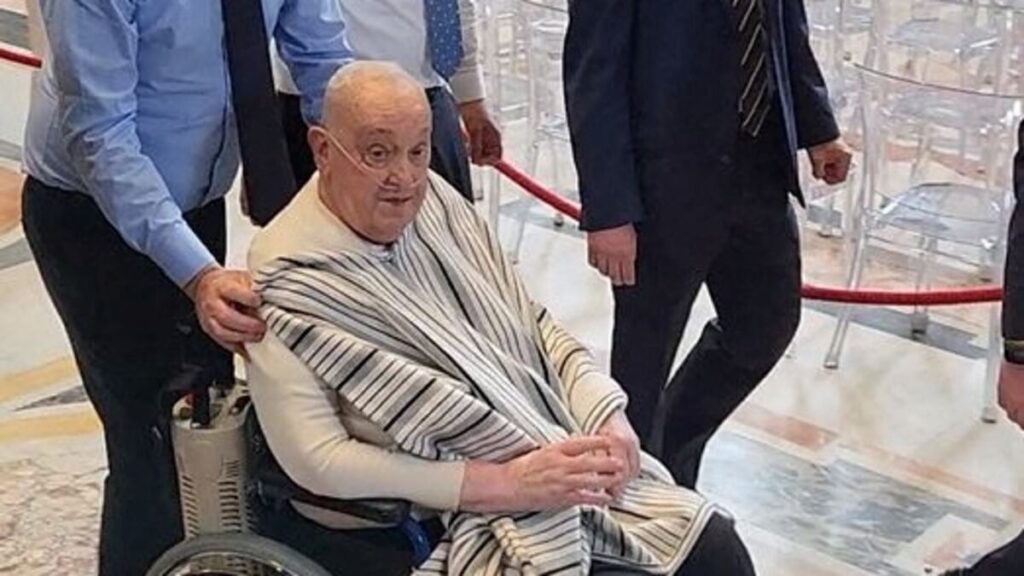
Pope Francis continues his recovery at Santa Marta with signs of improvement
Exaudi Staff
11 April, 2025
1 min
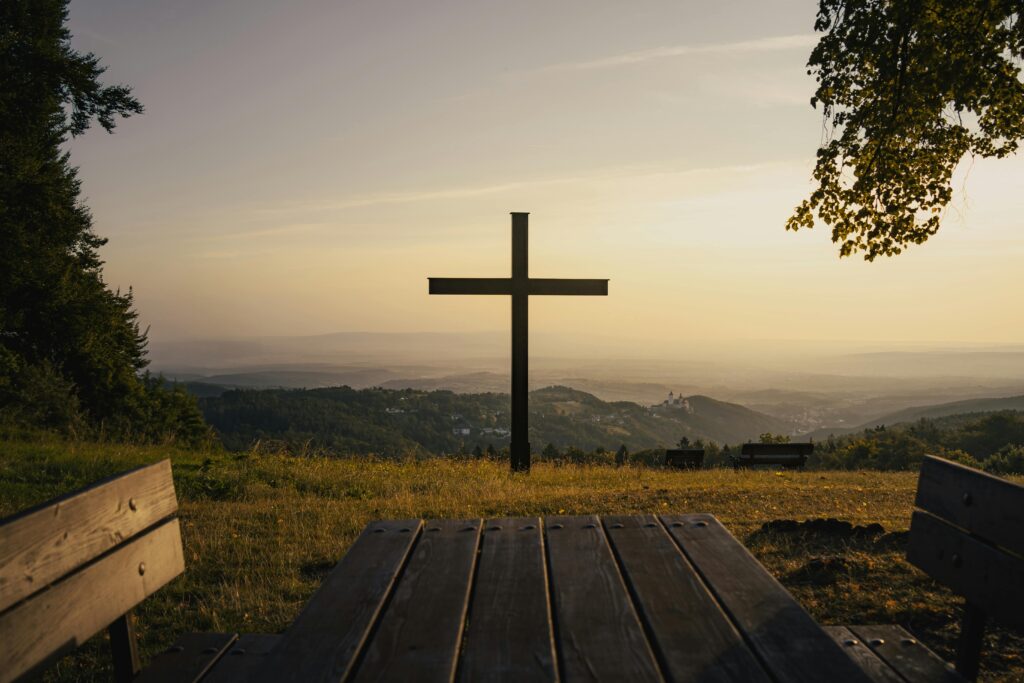
Syncretism and the Relativization of Faith: The Challenge of Religious Relativism in a Pluralist World
Javier Ferrer García
11 April, 2025
5 min

Do I Know How to Exercise Authority Over My Children?
José María Contreras
11 April, 2025
2 min
 (EN)
(EN)
 (ES)
(ES)
 (IT)
(IT)

